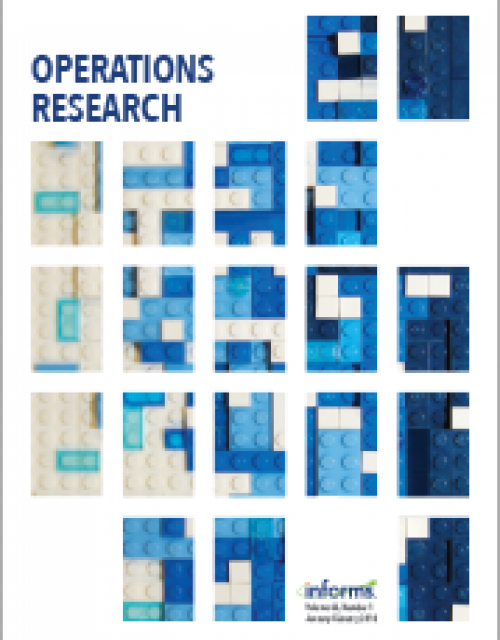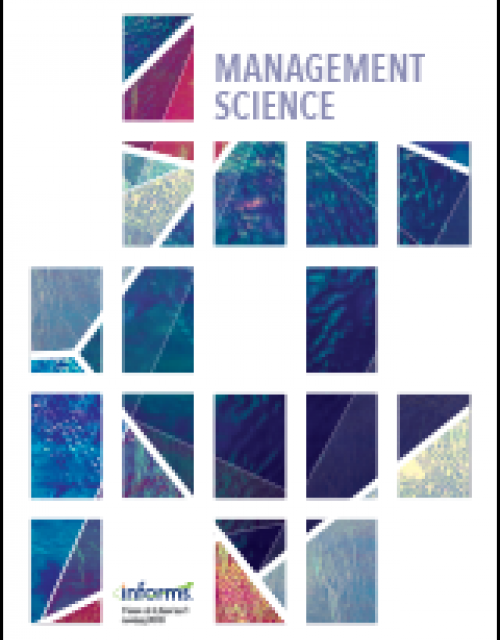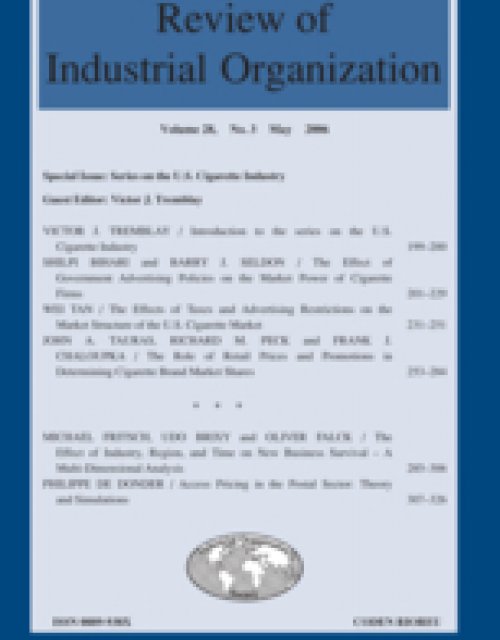Publication records
Subject(s)
Management sciences, decision sciences and quantitative methods
Keyword(s)
Sequential decision making, time pressure, information search, Bayesian inference
Arrow et al. (1949) introduced the first sequential search problem, “where at each stage the options available are to stop and take a definite action or to continue sampling for more information." We study how time pressure in the form of task accumulation may affect this decision problem. To that end, we consider a search problem where the decision maker (DM) faces a stream of random decision tasks to be treated one at a time, and accumulate when not attended to. We formulate the problem of managing this form of pressure as a Partially Observable Markov Decision Process, and characterize the corresponding optimal policy. We find that the DM needs to alleviate this pressure very differently depending on how the search on the current task has unfolded thus far. As the search progresses, the DM is less and less willing to sustain high levels of workloads in the beginning and end of the search, but actually increases the maximum workload she is willing to handle in the middle of the process. The DM manages this workload by first making a priori decisions to release some accumulated tasks, and later by aborting the current search and deciding based on her updated belief. This novel search strategy critically depends on the DM's prior belief about the tasks, and stems, in part, from an effect related to the decision ambivalence. These findings are robust to various extensions of our basic set-up.
© 2019, INFORMS
Volume
70
Journal Pages
1293–1952
Subject(s)
Human resources management/organizational behavior
Keyword(s)
Employer attractiveness, organizational commitment, current employees, existing employees, employer brand
JEL Code(s)
M12
With the growing interest in employer attractiveness, research is unsystematic on how this phenomenon can be conceptualized and studied. Studies tend to make little conceptual differentiation regarding for whom employers should be attractive, and therefore, address the perspectives of potential as well as current employees, who work in organizations for long periods of time. In this study our arguments relate to the phenomenon’s conceptual clarity as well as its differentiation from other related concepts. By focusing on employer attractiveness for current employees, we have systematically reviewed 48 studies published in business and management journals, and categorized findings into the Inputs-Mediators-Outputs model. This approach allowed us to depict significant limitations in the existing knowledge about employer attractiveness from the current employees’ perspective, and offer avenues for future research. Next, to delineate the future research agenda, we have concluded this study with a discussion on what our findings mean for managers and organizations.
Volume
13
Keyword(s)
hedge funds, cash flows, hot hand fallacy, performance streaks, relative weights, smart money
Cash flows to hedge funds are highly sensitive to performance streaks, a streak being defined as subsequent quarters during which a fund performs above or below a benchmark, even after controlling for a wide range of common performance measures. At the same time, streaks have limited predictive power regarding future fund performance. This suggests investors weigh information suboptimally, and their decisions are driven too strongly by a belief in continuation of good performance, consistent with the “hot hand fallacy.” The hedge funds that investors choose to invest in do not perform significantly better than those they divest from. These findings are consistent with overreaction to certain types of information and do not support the notion that sophisticated investors have superior information or superior information processing abilities.
© 2021, INFORMS
Volume
68
Journal Pages
4151–4172
Subject(s)
Technology, R&D management
Keyword(s)
patents, drugs, data exclusivity, clinical trials
JEL Code(s)
K41, L24, L65, O31, O32, O34
Volume
104
Journal Pages
574–586
Subject(s)
Human resources management/organizational behavior
Keyword(s)
methods, measures, research transparency, open science,reproducibility, meta-science, negotiation,conflict, cooperation, competition
Conflict management scholars study mixed-motive negotiation situations with cooperative and competitive incentives predominantly through multi-issue negotiation tasks in experimental studies. Intriguingly, experimenters currently lack an objective, generalizable, and continuous measure that precisely quantifies the incentives underlying these negotiation tasks. We present the conflict strength coefficient, which enables scholars to systematically quantify the incentive structures in these multi-issue negotiation tasks. By making the incentive structures accessible and numerically comparable, the conflict strength coefficient provides new insights into the central element of the experimental study of negotiation and conflict management, unmasks differences across existing tasks, facilitates research transparency, knowledge sharing, and open science practices. We demonstrate the coefficient’s benefits by providing a hands-on example from past research, by reviewing and quantitatively assessing the current literature, and by mapping conflict strength coefficients for the negotiation and conflict management research landscape and its subareas. Our analysis suggests that the conflict strength coefficient can enrich the understanding of cooperative and competitive incentives in the established tasks and directly guide and support an individual scholar’s process of knowledge creation. The conflict strength coefficient provides a methodological contribution to the experimental study of conflict management and negotiation with immediate benefits for the production of scientific knowledge, the experimental study of real-world phenomena, and theory development.
Volume
8
Subject(s)
Strategy and general management; Technology, R&D management
Keyword(s)
autonomy, remote work, flat organizations
Volume
11
Journal Pages
27–29
ISSN (Online)
2245-408X
Subject(s)
Unspecified
Keyword(s)
attorney perceptions, sexual violence, coercive tactics, measurement, cross-cultural research
In order to study sexual violence internationally, it is helpful to understand similarities and differences in how sexual violence is conceptualised across countries. The current study examined prosecuting attorneys’ judgments about which sexual tactics legally qualify as sexual violence in two countries. Attorneys from the U.S. (n = 28) and Colombia (n = 24) evaluated whether 36 tactics would qualify as a sexual offense in their jurisdiction. Although Colombian and U.S. attorneys agreed on the legality of many tactics, Colombian attorneys judged more behaviours as criminal, on average, than U.S. attorneys. Within-country variations suggested that differences were due not only to different legal statutes, but also to different interpretations of laws. Open-ended responses illustrated sources of ambiguity, including lack of clarity about how much coercion is required and which behaviours indicate nonconsent. This suggests that vagueness within legal definitions may allow attorney judgements to be influenced by stereotypes and prejudices.
Practical Impact Statement: This study illustrates the vagueness of legal definitions of sexual violence in two countries—the United States and Colombia. This vagueness provides prosecuting attorneys with substantial power to interpret the law, and in this study, some attorney judgements of legality seemed to be influenced by stereotypes. Greater training for law students and attorneys about the realities of sexual violence may be helpful in undermining belief in rape myths that may inhibit attorneys from prosecuting certain sexual violence cases.
Practical Impact Statement: This study illustrates the vagueness of legal definitions of sexual violence in two countries—the United States and Colombia. This vagueness provides prosecuting attorneys with substantial power to interpret the law, and in this study, some attorney judgements of legality seemed to be influenced by stereotypes. Greater training for law students and attorneys about the realities of sexual violence may be helpful in undermining belief in rape myths that may inhibit attorneys from prosecuting certain sexual violence cases.
Volume
28
Journal Pages
261–279
ISSN (Online)
1742-6545
ISSN (Print)
1355-2600
Subject(s)
Diversity and inclusion; Health and environment; Technology, R&D management
Keyword(s)
Crowd science, citizen science, crowdsourcing, problem solving, problem finding, agenda setting, organization of science
Scientists are increasingly crossing the boundaries of the professional system by involving the general public (the crowd) directly in their research. However, this crowd involvement tends to be confined to empirical work and it is not clear whether and how crowds can also be involved in conceptual stages such as formulating the questions that research is trying to address. Drawing on five different “paradigms” of crowdsourcing and related mechanisms, we first discuss potential merits of involving crowds in the formulation of research questions (RQs). We then analyze data from two crowdsourcing projects in the medical sciences to describe key features of RQs generated by crowd members and compare the quality of crowd contributions to that of RQs generated in the conventional scientific process. We find that the majority of crowd contributions are problem restatements that can be useful to assess problem importance but provide little guidance regarding potential causes or solutions. At the same time, crowd-generated research questions frequently cross disciplinary boundaries by combining elements from different fields within and especially outside medicine. Using evaluations by professional scientists, we find that the average crowd contribution has lower novelty and potential scientific impact than professional research questions, but comparable practical impact. Crowd contributions outperform professional RQs once we apply selection mechanisms at the level of individual contributors or across contributors. Our findings advance research on crowd and citizen science, crowdsourcing and distributed knowledge production, as well as the organization of science. We also inform ongoing policy debates around the involvement of citizens in research in general, and agenda setting in particular.
With permission of Elsevier
Volume
51
Journal Pages
104491
Subject(s)
Management sciences, decision sciences and quantitative methods; Product and operations management
Keyword(s)
Product proliferation, lead-time reduction, process redesign, delayed differentiation
Product proliferation occurs in supply chains when manufacturers respond to diverse market needs by trying to produce a range of products from a limited variety of raw materials. In such a setting, manufacturers can establish market responsiveness and/or cost efficiency in alternative ways. Delaying the point of the proliferation helps manufacturers improve their responsiveness by postponing the ordering decisions of the final products until there is partial or full resolution of the demand uncertainty. This strategy can be implemented in two different ways: (1) redesigning the operations so that the point of proliferation is swapped with a downstream operation or (2) reducing the lead times. To establish cost efficiency, manufacturers can systematically reduce their operational costs or postpone the high-cost operations. We consider a multi-echelon and multi-product newsvendor problem with demand forecast evolution to analyze the value of each operational lever of the responsiveness and the efficiency. We use a generalized forecast-evolution model to characterize the demand-updating process, and develop a dynamic optimization model to determine the optimal order quantities at different echelons. Using anonymized data of Kordsa Inc., a global manufacturer of advanced composites and reinforcement materials, we show that our model outperforms a theoretical benchmark of the repetitive newsvendor model. We demonstrate that reducing the lead time of a downstream operation is more beneficial to manufacturers than reducing the lead time of an upstream operation by the same amount, whereas reducing the upstream operational costs is more favorable than reducing the downstream operational costs. We also indicate that delaying the proliferation may cause a loss of profit, even if it can be achieved with no additional costs. Finally, a decision typology is developed, which shows effective operational strategies depending on product/market characteristics and process flexibility.
Volume
31
Journal Pages
1135–1156
Subject(s)
Economics, politics and business environment
Keyword(s)
Reverse privatization, solid waste collection, mixed oligopoly, state-owned enterprises, competition law enforcement, logit regression
JEL Code(s)
L33, L44, L88, H44, K21
After earlier waves of privatization, local governments have increasingly taken back control of local service provisions in some sectors and countries and instead started providing those services themselves (reverse privatization). Using a unique panel dataset on the mode of service provision for solid waste collection for German municipalities that cover the years 2003, 2009, and 2015, we investigate the motives for reverse privatization. Our results show that -- in deciding whether to insource or not -- municipalities react to the cost advantages of private suppliers as well as to the competitive environment and municipal activity: There is more switching to insourcing in concentrated markets and in markets with horizontally or vertically related public services. Local interest groups influence this decision as well.
© 2022 Springer
Journal Pages
217–261


